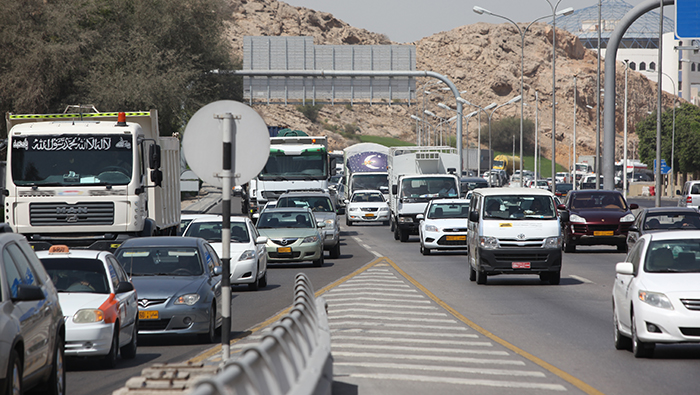
Muscat: For anyone in Oman feeling frustrated by a daily commute, a new survey suggests there’s actually much to appreciate about the country’s traffic conditions as their commute times are among the shortest in the Arab world.
According to Numbeo’s Mid-Year 2024 Traffic Index, Oman ranks as the least congested Arab city and one of the most efficient worldwide in terms of traffic flow.
On average, commuters in Oman spend only 19.9 minutes in traffic each day.
This is a stark contrast to cities like Lagos, Nigeria, where drivers endure an average of 68.8 minutes in traffic daily - the longest in the world. Closer to home, residents in neighbouring Dubai face 36.3 minutes of traffic each day, nearly double that of Oman’s commuters.
The survey ranks Oman 161st globally in terms of traffic congestion, making it the least crowded city traffic-wise in the Arab world.
Following Oman in the Arab region are Doha, where residents spend about 29.2 minutes in traffic, and Jeddah with an average of 30.5 minutes daily.
Other cities include Abu Dhabi at 32.9 minutes, Riyadh at 32.5 minutes, Kuwait at 34.5 minutes, and Dubai at 36.3 minutes.
Speaking to Times of Oman, Brig-Eng. Ali Sulayem Al Falahi, Director General of Traffic at Royal Oman Police, said: “Undoubtedly, the Sultanate’s roads are among the best in the world, having achieved advanced positions in their quality over the past twenty years, including the tenth in the world.”
He also said, “As for traffic congestion, the Sultanate is the least congested in the Gulf countries and among the best Arab countries compared to the capitals of these countries, as the average delay in daily trips does not exceed 20 minutes on average for distances exceeding fifty kilometers, which is considered a good rate in travel time.”
He attributed this to the great efforts made by the Royal Oman Police, represented by the General Directorate of Traffic, in coordination with the competent authorities concerned with the roads and transportation sector in the Sultanate of Oman. “Starting from designing and implementing roads, maintaining their maintenance and optimal use, monitoring road users, imposing traffic control, educating and raising awareness of the public about the importance of maintaining the application of the traffic system and rules, monitoring speeds, and monitoring traffic violations that may lead to traffic congestion as a result of the behavior of some drivers.”
He also said, “All these efforts combined have led to these successes that are evident to the eye and are of interest to tourists before residents because the tourist compares traffic movement in different countries where he finds that the roads of the Sultanate represent a model among the roads of other countries that these tourists may have visited.”
He continued that efforts will continue from various parties to make the roads of the Sultanate of Oman safer for its users and a model to be emulated among countries.
The Numbeo’s Mid-Year 2024 Traffic Index report also cited how other global cities are struggling with extreme congestion including Los Angeles, Colombo, Delhi, and Dhaka, each with substantial commute times and inefficiency ratings.
Numbeo’s Traffic Index considers multiple factors such as average commute times, overall traffic satisfaction, CO₂ emissions, and systemic inefficiencies.
These metrics create a more comprehensive picture of urban traffic experiences, underscoring not only travel delays but also environmental and social impacts of congestion.
The high Traffic Index score of 354.5 in Lagos signifies extreme congestion, while Oman’s Index of 111.3 underscores its relatively smooth traffic flow.
Oman’s success in maintaining manageable traffic conditions can be attributed to well-maintained infrastructure, a relatively low population density, and strategic urban planning.
The roads in Muscat and across major cities have been designed to facilitate smooth flow, reducing the potential for long delays that are often found in cities with denser populations or sprawling urban landscapes.
Moreover, Oman has invested significantly in recent years in infrastructure projects aimed at improving connectivity and reducing travel times between key areas. New road networks and bridge constructions have contributed to the ease of travel for residents and commuters.
Such projects, coupled with a focus on sustainable and low-emission transportation initiatives, align with Oman’s Vision 2040 strategy, which aims to support quality of life improvements across various sectors, including transportation.
While Oman’s relatively smooth flow might surprise some, congestion remains a global challenge, especially in rapidly growing urban areas.
In cities like Los Angeles, Colombo, and Dhaka, the sheer number of cars on the road often outpaces infrastructure growth. This, combined with factors like rapid urbanisation, inadequate public transportation options, and high vehicle ownership, exacerbates congestion issues.
The Traffic Index serves as a valuable tool for city planners and governments worldwide, offering insights into where challenges are most severe and what factors contribute to the best solutions.
Oman’s performance in the Index suggests that its current strategies are working and that other cities with high levels of congestion might look to Oman’s model as a potential roadmap.
Numbeo, the global database providing the Traffic Index, gathers current and reliable data across multiple domains, including cost of living, crime, healthcare, and pollution. The data is primarily sourced from user contributions and local surveys, offering valuable perspectives on living conditions for cities worldwide.